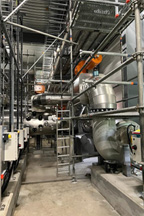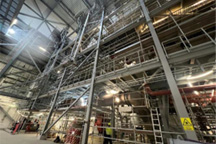In January 2024, Professors Willy Shih and Mike Toffel led 45 HBS MBA students on site visits to witness the energy transition and innovative sustainable production activities throughout Denmark and the Netherlands, in the second year of their Immersive Field Course (IFC). This is one of nine student essays that highlight their reflections.
As part of our Immersive Field Course (IFC), we had the privilege of visiting Port Esbjerg, a key player in the offshore wind sector that has the largest capacity for offshore wind installation in the world. Our tour was hosted by Jesper Bank, Chief Commercial Officer, and Dr. Dennis Jul Pedersen, CEO of Port Esbjerg. Their insights painted a vivid picture of the port's strategic role in supporting nearly 60 offshore wind projects, with over 90% of Europe's wind capacity passing through the site. Originally the port began as a fishing hub in 1874 and transitioned increasingly to serve oil and gas companies. However, in recent years, the port has undergone another transition, to meet the growing demand for offshore wind. Our visit was divided into four parts: an introductory presentation, a visit to an operating turbine, a visit to INEOS Energy and a presentation by Total Energies, and a walkthrough of the port’s district heating plant. Port Esbjerg offered us a unique perspective on how a port can be a central hub in the transition to renewable energy.
Adapting Infrastructure for Green Giants
To cater to the massive scale of offshore wind operations, Port Esbjerg has undergone significant change over time. The port's infrastructure, including roads redesigned for transporting colossal wind turbine blades, highlights the commitment to renewable energy. Every roundabout at the port has been designed to allow trucks with turbine blades to be able to pass through easily, a testament to the port's adaptability. We observed the storage of wind turbine nacelles, where meticulous care is taken to rotate the hubs weekly to prevent alignment issues, and the use of drones for surveying the flexible storage area.
Up Close with Wind Turbines
A highlight of our visit was the opportunity to get up close to a wind turbine. Standing beneath these towering structures, one cannot help but be awestruck by their scale and the complexity of their design and construction. The sheer size of the blades, the engineering required to balance and rotate them, and the sophistication of the energy generation process were all palpable in this encounter. To see an operational wind turbine early in the trip was great context for many of the subsequent visits that explored individual turbine components.
The turbine we viewed was a 9.5 MW turbine that cost approximately USD 20 million to build.

Transitioning to Greener Energy Solutions
We toured Port Esbjerg's municipality owned non-profit district heating center, Din Forsyning, which is still under construction and in the process of transitioning from coal to biomass and seawater-based heat pumps. This transformation represents a complete overhaul of operational philosophy, and demonstrates how the shift from fossil fuels to renewable energy requires higher capital investment but yields lower operational costs.
This transition is abundant with innovative solutions. The heat pumps used to extract energy from sea water and inject it into the town’s district heating system are custom designed and constructed. They utilize CO2 as a refrigerant working fluid, as it eliminates the risks associated with ammonia or chlorofluorocarbons which damage the atmosphere. An ammonia-based system would have put both the nearby residents and marine life in jeopardy if there was ever a system leak.
One of the district heating center’s main functions is to conduct load balancing - buying electricity to operate their sea-water heat pump when power is cheaper, then storing heat as hot water and sending it to customers when electricity prices are higher, thus lowering heating rates and helping to balance the grid.


Piloting Carbon Capture and Storage
We then visited INEOS Energy, a sustainable energy business conducting the Greensand Pilot Project, an INEOS-led consortium of 25 companies and institutions, for carbon capture and storage (CCS). The project uses liquid CO2 produced from biogas plants already in operation. The CO2 is injected offshore into an existing well using proven technology. Biomass with CCS is one way to go beyond carbon neutral into carbon negative. The project cost about 50 million euros and has resulted in capturing 4,000 tons of CO2. The team foresees savings on ETS compliance quotas, national CO2 taxes, voluntary carbon credits, or carbon dioxide removal credits as potential sources of revenue.
Legacy Industries in a Sustainable Transition
Our tour also included a visit to Total Energies, a company with a long history in oil and gas. It was enlightening to learn about their shift towards renewable energy production and CCS, with plans to inject captured carbon into depleted oil fields in the North Sea. Total is targeting 50% renewables in their portfolio mix by 2050. Their strategy represents a significant move towards sustainable practices in traditional energy sectors.
Conclusion
Port Esbjerg is more than a hub for offshore wind; it is a beacon of how industries can pivot towards a sustainable future. The visit left us with a profound understanding of the complexities and innovations driving the green transition in industrial sectors. It's a story of a historic port embracing the winds of change, literally and figuratively, to lead in the era of renewable energy.

